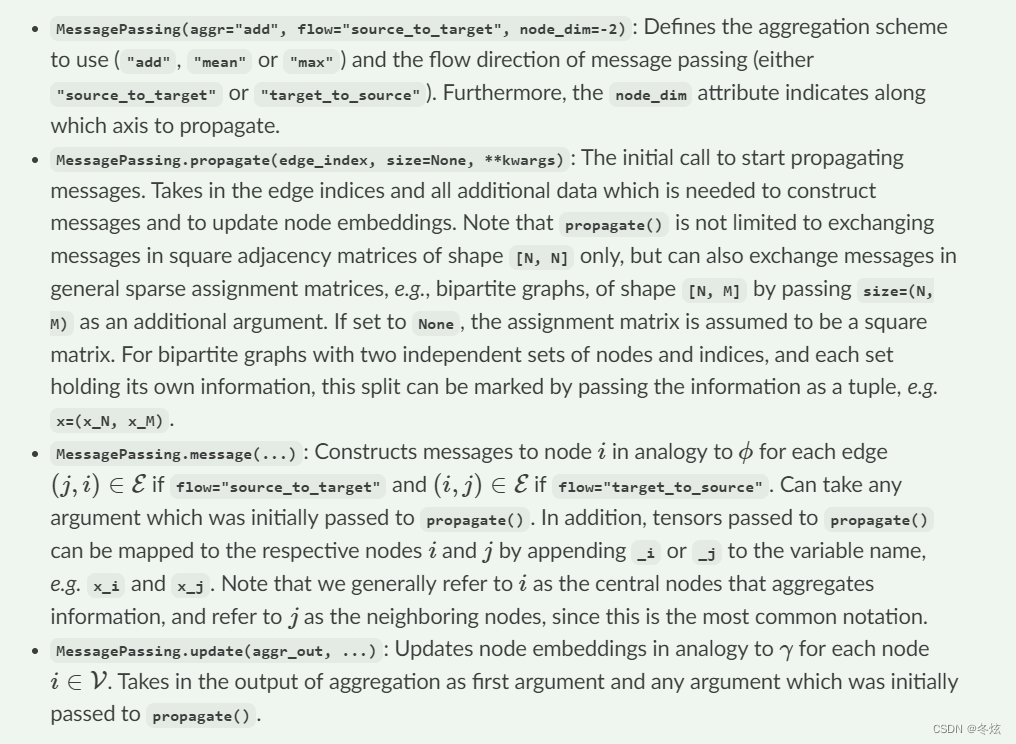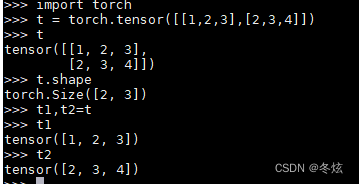0.import torch_geometric 的Data 查看_冬炫的博客-CSDN博客_import torch_geometric
1. import torch_geometric 加载一些常见数据集_冬炫的博客-CSDN博客_torch_geometric 数据集
2. torch_geometric mini batch 的那些事_冬炫的博客-CSDN博客

1. 节点更新公式复习
上一节我们只是调用了常规的GCN layer. 但是有时候我们根据自己的需要需要自己定义新的GCN 卷积操作。这时候就需要自定义网络。
所以这一节主要看GCNlayer 里面的邻居信息如何传播,或者自己如何改。
上面公式就是常见的节点更新公式。其中k 为图层的序号。r 为更新公式,就是邻居信息和之间边的信息的聚合表示。 正方形代表聚集邻居信息成一个向量。i 代表当前节点序号。j 为邻居节点序号。
2. 一些基础类
 Message Passing 基础类就可以满足上面公式的实现,其中我们可以自定义 邻居及边融合的函数message() 和当前节点的更新公式update() 例如 add mean max
Message Passing 基础类就可以满足上面公式的实现,其中我们可以自定义 邻居及边融合的函数message() 和当前节点的更新公式update() 例如 add mean max

MessagePassing(aggr = "add", flow="source_to_target", node_dim=2)
我认为应该指的就是上面的公式,node_dim 指的应该在哪个维度聚合。当然是节点个数的那个维度,最后一个维度是节点的特征维度所以最终选择 -2
然后介绍了一些message 和update函数的细节。感觉具体的参数传递还是得看例子中如何调用。
Let us verify this by re-implementing two popular GNN variants, the GCN layer from Kipf and Welling and the EdgeConv layer from Wang et al..
3. 实现一个GCN Layer层

上面就是需要实现的更新公式
我们可以看到邻居节点与本身节点序号合并,也就是有自环
-
Add self-loops to the adjacency matrix. 首先加入自环 边
-
Linearly transform node feature matrix. W 的矩阵实现,线性层
-
Compute normalization coefficients. 入度出度计算
-
Normalize node features in ϕ. 构成归一化项(分母)
-
Sum up neighboring node features (
"add"aggregation). 将邻居节点及自己的特征相加 -
Apply a final bias vector. 应用一个 b 向量。
其中4,5 会涉及到上面的基础类MessagePassing. 1-3 只是特征预处理阶段

import torch
from torch.nn import Linear, Parameter
from torch_geometric.nn import MessagePassing
from torch_geometric.utils import add_self_loops, degree
class GCNConv(MessagePassing):
def __init__(self, in_channels, out_channels):
super().__init__(aggr='add') # "Add" aggregation (Step 5).
self.lin = Linear(in_channels, out_channels, bias=False) # bias 只是最后加
self.bias = Parameter(torch.Tensor(out_channels)) #这就是最后加入的bias, 维度就是输出的节点特征维度
self.reset_parameters()#重置学习的参数和bias
def reset_parameters(self):
self.lin.reset_parameters()
self.bias.data.zero_()
def forward(self, x, edge_index):
# x has shape [N, in_channels] 就是一个mini batch 的 大图。N 指的就是节点个数,in_channels 就是输入节点的特征维度
# edge_index has shape [2, E] 就是边的稀疏连接矩阵
# Step 1: Add self-loops to the adjacency matrix.
edge_index, _ = add_self_loops(edge_index, num_nodes=x.size(0))# 直接利用函数,就可以在原先的节点边的链表中添加 自环边。操作应该就是 append 对应扩展。x.size(0)指的就是大图的节点个数
# Step 2: Linearly transform node feature matrix.
x = self.lin(x)
# Step 3: Compute normalization.
row, col = edge_index #按照方向,应该是row 指的是源节点邻居节点,col 指的是当前节点,row 是箭头的始端,col 是箭头的尾端
deg = degree(col, x.size(0), dtype=x.dtype)# 这样如果是有向图,应该就是入度
deg_inv_sqrt = deg.pow(-0.5)
deg_inv_sqrt[deg_inv_sqrt == float('inf')] = 0 # 指的对有些节点没有边入的处理。1/0 的除不尽用0 表示,也就是归一化系数为0 。
norm = deg_inv_sqrt[row] * deg_inv_sqrt[col] # 根据边 将每个边的归一化系数求出。
# Step 4-5: Start propagating messages.
out = self.propagate(edge_index, x=x, norm=norm)
# 这里我们要注意的就是propagate的参数维度。edge_index [2, E], x 还是[N, out_channels],norm 是[E, ]
# Step 6: Apply a final bias vector.
out += self.bias
return out
def message(self, x_j, norm):
# x_j has shape [E, out_channels]
# Step 4: Normalize node features.
return norm.view(-1, 1) * x_jWe then call propagate(), which internally calls message(), aggregate() and update().
propagate 中间会自动调用 message 、aggregate 、 update 函数们。
外层调用咱门编写的GCN Conv类
conv = GCNConv(16, 32)
x = conv(x, edge_index)























 4945
4945











 被折叠的 条评论
为什么被折叠?
被折叠的 条评论
为什么被折叠?








